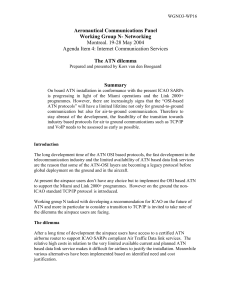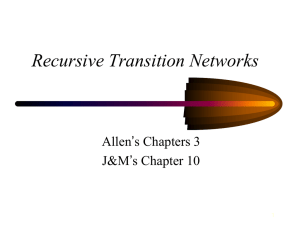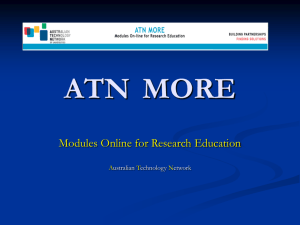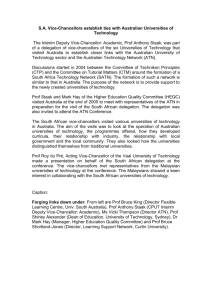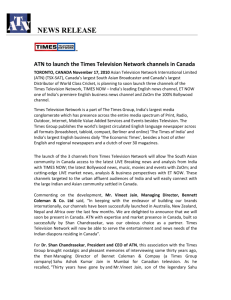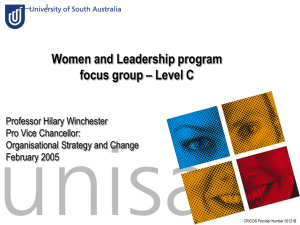Women Leaders in Universities in Hong Kong & China: Challenges, Tensions,
advertisement
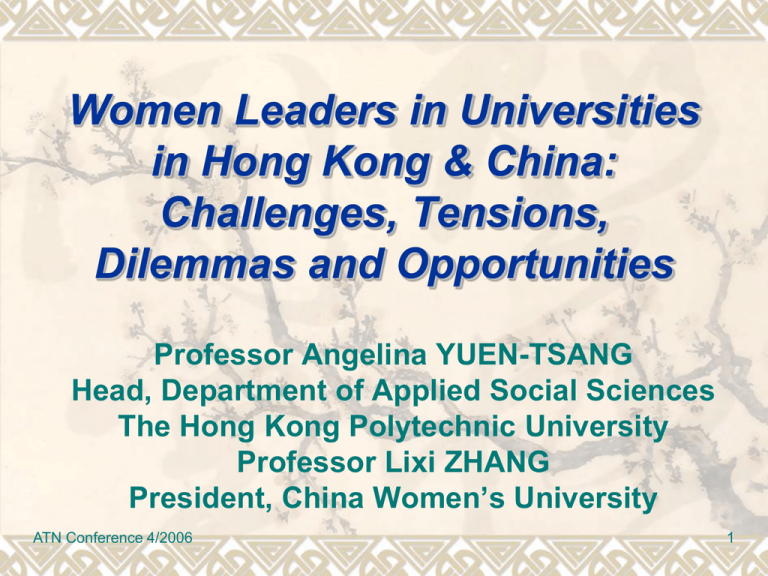
Women Leaders in Universities in Hong Kong & China: Challenges, Tensions, Dilemmas and Opportunities Professor Angelina YUEN-TSANG Head, Department of Applied Social Sciences The Hong Kong Polytechnic University Professor Lixi ZHANG President, China Women’s University ATN Conference 4/2006 1 Some Facts Figures of women in leadership in Hong Kong & China: In the Chinese mainland (2004): - 9.9% at the ministry level or above - 12.6% at the bureau-level or above In Hong Kong: 10.5% of all Policy Secretaries (2004/5) 19% in the Executive Council (2004/5) 18% in Legislative Council (2004/5) ATN Conference 4/2006 2 Proportion of Female Teachers In Universities in the Chinese mainland (%): 38.2% (2000) Only 4 Presidents out of 73 national level Universities (2006). Proportion of Female Teachers In Hong Kong: 8% at professor grade (2001/02) 15% at senior lecturer grade (2003) Only 1 female Pro-Vice Chancellor in the history of higher education up to now (already retired) out of 8 Universities. ATN Conference 4/2006 3 Our Question Why do Chinese women leaders in Universities succeed in getting to the top? What are the tensions and challenges they face in the process? What are the opportunities they are given? What are the implications for policy and practice? ATN Conference 4/2006 4 Our Research • • • • We interviewed 10 Chinese women leaders Universities in Hong Kong and China (Deans and above in Hong Kong, Vice Presidents and above in China). More to be interviewed. We used a life course perspective in our research design We conducted in-depth interviews We used the grounded theory in our analysis ATN Conference 4/2006 5 Our Initial Theory: Balancing Tensions That Chinese women leaders in Universities have to skillfully engage in the art of balancing tensions in all dimensions both in their private and public spheres in order to get to the top. Under existing circumstances, the process is harsh, demanding, straining and eliminating, and only the “fittest” can survive. ATN Conference 4/2006 6 Our Initial Explanations 1. Entrenched Chinese Patriarchal Culture: Traditional values on gender relationships: Three Subordinations: “A woman has to subordinate to her father in youth, her husband in maturity, and her son in old age”. “Men are responsible for outside, women for inside”. “Men are superior, and female are inferior”. “Virtuous women are those without talents”. ATN Conference 4/2006 7 - These patriarchal values are deeply entrenched in the Chinese culture and are still affecting gender relationships in Chinese societies both in the private and the public arenas. - Women in the academia are still expected to perform most of the “feminine” roles at home (cooking, homemaking, childcare, elder care, etc.) regardless of their positions and social status. ATN Conference 4/2006 8 2. Negative Impact of Equality Policies and Conceptions: - In emphasizing on absolute equality between male and female through the introduction of equality policies and practices, women in the academia are expected to perform and to be assessed exactly the same ways as men without regard to their special needs, characteristics and life course demands. ATN Conference 4/2006 9 ` As a result of the above multiple demands: Women have to balance tensions at home in order to be a “virtuous woman”. Women have to balance tensions in the workplace and to perform as competently as men in the workplace in order to excel. Women also have to balance the tensions between their private and the public spheres in order to maintain a proper equilibrium in their roadmap to University leadership. ATN Conference 4/2006 10 Private Sphere Multiple Family Roles -wife -mother -daughter -in-law etc. Public Sphere BALANCE Multiple Roles in the Academia -teacher -researcher -administrative leader -relationship builder etc. Chinese Women’s Need to Balance Tensions in both the public and private spheres ATN Conference 4/2006 11 Life Course Development of Chinese Women Leaders in Universities 1. Childhood and youth: In most cases, gender identity was not apparent during childhood. Many were not treated as “girls” in their childhood. Many grew up in families which emphasized on educational achievements. Many interviewees reported that they were given heavy household responsibility and leadership duties at home because of their roles as eldest sisters. ATN Conference 4/2006 12 2. Education and entry to the academia: All of them had excellent academic achievements in primary and secondary schools and in Universities They enjoyed relatively smooth sail in their early years in the academia and they were not particularly aware of, or bothered by, the impact of gender on their work performance and assessment while occupying junior positions. ATN Conference 4/2006 13 ` 3. Marriage and family formation: Majority of interviewees perceived marriage and family formation as a natural and logical step in their life course development . Tendency to select husbands who are capable and who can command their respect. Most of them give birth to their child/children within a few years of their marriage. Two did not have children because of their failure to do so. ATN Conference 4/2006 14 Many interviewees have given up career pursuits (going abroad to study, actively seeking promotion, involving in prestigious research projects, getting academic papers published) at certain point of their life because of family demands and childcare responsibilities. ATN Conference 4/2006 15 4. Advancement and promotion at work: Most interviewees prefer to stay as academics and did not actively seek for promotion to leadership positions. Many were “invited”, “persuaded”, or even “coerced” to make applications/take up appointments by their seniors/mentors because of the “collective good”. Interviewees were often apprehensive, or even reluctant to apply/accept promotion opportunities, especially during periods of excessive family demands. ATN Conference 4/2006 16 Interviewees were fearful of the maledominated organizational culture of senior management in Universities, characterized by aggressiveness, power politics, and exclusive networks among male colleagues. Interviewees also reported negative comments from both male and female colleagues towards women leaders in Universities as “ambitious” and “aggressive”. They were often regarded negatively as “superwomen”. ATN Conference 4/2006 17 Some interviewees were promoted because of the need to include the female gender in the leadership team. Some were promoted because of their communication and interpersonal skills, and their ability to mediate conflicts among staff and students. For those who actively sought to be promoted, they had to fight extremely hard in the process even though they perceived their abilities to be far superior than their male competitors. ATN Conference 4/2006 18 5. Staying in University leadership: Interviewees experienced excessive pressure and tensions since they were expected to excel in their academic and administrative leadership, in their ability to handle interpersonal relationships. At the same time, they have to perform their multiple roles at home just as other Chinese women. ATN Conference 4/2006 19 Some preferred to leave their management roles (if there is the choice) and to return to their academic positions because of their uneasiness with the male-dominated organizational culture of Universities. It was lamented that: “Women leaders in the academia have to perform 200% while men only have to do 100% in order to have the same level of achievement!” ATN Conference 4/2006 20 Differential achievements of men and women in Universities in the life course ATN Conference 4/2006 21 Paths to University Leadership 1. Academic excellence: Academic excellence of the interviewees was a fundamental factor contributing to their future rise to leadership. 2. Capacity for communication and relationship building: Capacity to communicate and good interpersonal relationships was often cited as a critical factors contributing to their appointment/selection. ATN Conference 4/2006 22 3. Affirmative Policies: In the early 1990s, the Chinese Government launched a series of affirmative policies to promote women leaders in all levels of government, including the inclusion of women in senior leadership of Universities. The majority of women interviewees from China were promoted because of vacancies in their Universities for women leaders. ATN Conference 4/2006 23 4. Guidance from Mentors: Several interviewees were given valuable advice and guidance from mentors, who were usually males who were not gender-biased, on their career development. They were able to choose the strategic paths for development and have eventually succeeded. ATN Conference 4/2006 24 5. Strategic Positioning Only a few indicated that they had taken strategic steps on their own initiative to get to the top. They were determined to get the posts and lobbied for support in the elections and selection processes. But the process was tiring. 6. Unintended Promotion Many interviewees were promoted to positions of leadership reluctantly. They just happened to occupy the right posts at the right time. ATN Conference 4/2006 25 Challenges and Dilemmas 1. Gender role perception: Many interviewees were bounded by their own patriarchal values and beliefs: They hope that their husbands should have higher achievements. They think that women should perform their roles at home well despite their heavy responsibilities at work. They are complacent with their supportive roles in University management. Many prefer to be the “second in command”. ATN Conference 4/2006 26 2. Family Demands: They regard their families as having higher priority than their work. Many interviewees have forsaken career advancements at certain stage of their life course because of family demands. ATN Conference 4/2006 27 3. Male-dominated culture in Universities: The culture of Universities are maledominated. The academic procedures, promotion and appraisal systems, etc. are created and controlled by males. Voices of women academics are seldom represented. ATN Conference 4/2006 28 Implications for Policies & Practice 1. Gender Mainstreaming in Policy Making Processes: Affirmative policies in Universities should be introduced/continued in order to ensure the promotion of women to senior leadership positions. Women should be represented in key policy making committees of Universities in order to ensure that the women’s voices be held and be reflected in policies and practices. ATN Conference 4/2006 29 2. Network building among women leaders of Universities: To develop a network among women leaders in Universities so as to enhance their resilience, to provide mentorship, to develop mutual support, and to create a platform for policy advocacy. ATN Conference 4/2006 30 3. Training Programmes for Young Women Academics: To provide training and mentorship for young women academics so as to enhance their competitiveness and to provide support for their career advancement. This is particularly critical given the availability of promotion opportunities under the new appointment system. ATN Conference 4/2006 31 4. Development of supportive services and mechanisms to reduce the role burden of women: To provide all forms of supportive services and facilities to reduce the role burden of women and to enable them to pursue career advancement and personal fulfillment. ATN Conference 4/2006 32 5. Transforming Values and Shifting the Dominant Paradigm: Reduction and elimination of all forms of discrimination and traditional patriarchal values among men, women and the public through long-term educational programmes and affirmative actions. ATN Conference 4/2006 33 Thank you! ATN Conference 4/2006 34
